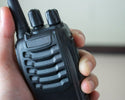
Reasons Your Two-Way Radios Are Losing Coverage
, by Joseph Gabriel, 2 min reading time

, by Joseph Gabriel, 2 min reading time

Two-way radios are lifelines in daily operations. Whether it’s coordinating a large private event or maintaining hospital safety, it’s essential to have a functional two-way radio in every employee’s hand.
If you've noticed that your two-way radios are losing coverage, it's time to uncover the reasons why and how to resolve them.
Solid materials absorb and reflect radio signals, which can lead to significant signal weakening. Each obstruction the signal passes through reduces the effective range, sometimes with unpredictable results.
Metallic surfaces and electronic equipment can act as formidable barriers to radio waves, often reflecting signals and causing unpredictable reception issues. Natural elements like hills and valleys also play a role, as they can either block or redirect the path of communication, impacting the signal strength.
Airwaves are hardly vacant; it's all too common for two-way radio signals to meet interference from other sources. Anything from high-voltage power lines to electric motors and even other communication devices can cause a racket in your radio transmissions. The resulting noise can lead to static, missed messages, or complete signal disarray.
Mitigating interference can involve relocating radios or using directional antennas to minimize disruptions. Sometimes, though, the solution is as simple as turning off competing equipment or avoiding high-interference periods.
The antenna is often neglected, yet so critical for two-way radios to function. It serves to receive and transmit radio signals. However, it can suffer from any number of maladies, including damage, incorrect handling, or trying to use it with an incompatible radio.
An improperly functioning antenna can cause erratic radio behavior, such as static noise, intermittent signal loss, and even overheating of the radio itself. This can significantly reduce the range and coverage of your radio even in optimal conditions.
Train your staff on the proper care and maintenance of antennas. This includes ensuring that the antenna is for the appropriate radio model, tightening it securely to the radio’s body, and keeping it straight and well-preserved.
Two-way radios have limits. One of the reasons why users lose coverage is because they’re unaware of the operational distance.
The more power you pump into a two-way radio, the further the signal reaches. For typical handheld radios, the range can be as little as half a mile in a city, while in open areas, the range can extend to several miles.
Be sure that your team is fully aware of the distance they may travel without losing connectivity. If needed, incorporate radio repeaters or signal boosters to maximize effectiveness.
In professions that require instantaneous responses, a fully functional Motorola portable radio that won’t lose coverage is just what you need! View Atlantic Radio’s amazing options and instantly improve operations.